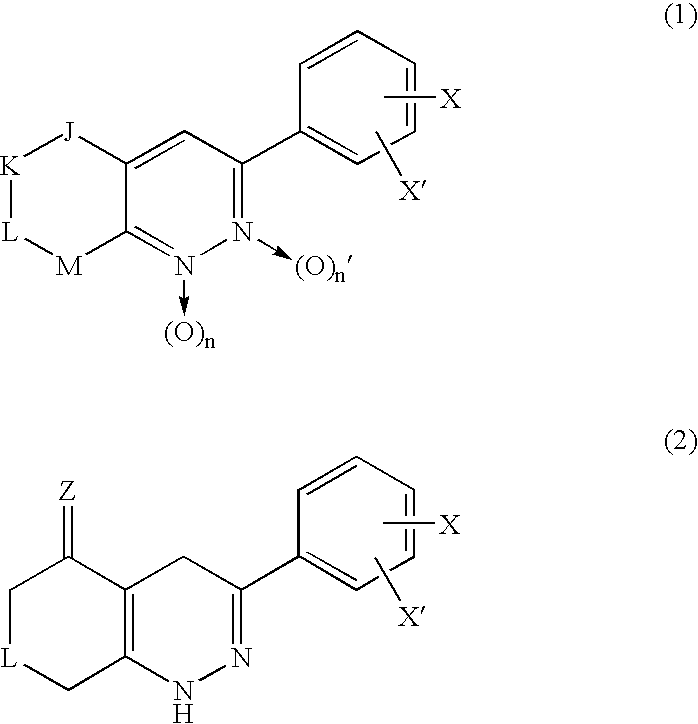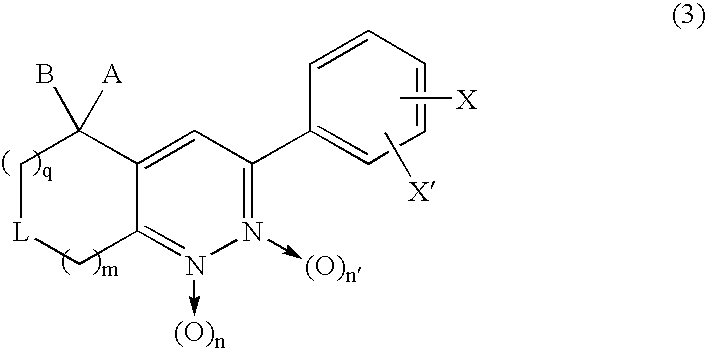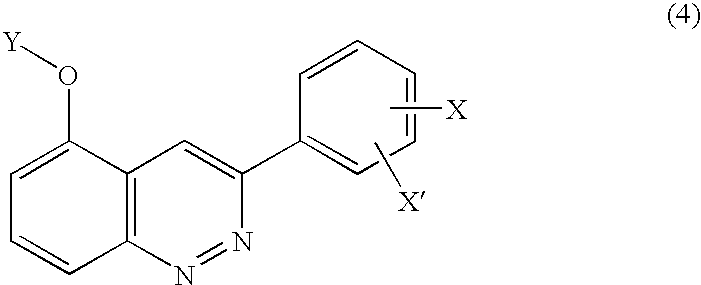3-Phenyl-cinnoline homologue and antitumor agent containing the same
a technology of phenylcinnoline and homologue, which is applied in the field of 3-phenylcinnoline analogue, can solve the problem of requiring a more difficult operation techniqu
- Summary
- Abstract
- Description
- Claims
- Application Information
AI Technical Summary
Problems solved by technology
Method used
Image
Examples
example 1
Synthesis of 7-phenyl-3-(3-trifluoro-methylphenyl)-7,8-dihydro-6H-cinnolin-5-one
[0086] A pyridine (5 ml) solution of 7-phenyl-3-(3-trifluoromethylphenyl)-4,6,7,8-tetrahydro-1H-cinnolin-5-one obtained in Reference Example 2 was stirred at 70° C. for 3 days. Residue obtained by concentration of the reaction liquid under reduced pressure was subjected to purification using silica gel column chromatography (hexane / ethyl acetate=3 / 1) to obtain a yellow crude product, which was further purified by suspension (hexane / ethyl acetate=3 ml / 0.5 ml) to obtain an objective compound (124.0 mg, 48.9% in 2 steps).
[0087]1H-NMR (200 MHzFT, TMS, CDCl3)
[0088] 2.93-3.23(2H,complex), 3.51-3.75(2H,complex), 3.76-3.97(1H,m), 7.20-7.49(5H,m), 7.70(1H,t,J=7.8 Hz), 7.80(1H,d,J=7.8 Hz), 8.31-8.42(1H,m), 8.46(1H,brs)
[0089] MS(ESI)
[0090] m / z 369 [M+H]+
example 2
Synthesis of ethyl 5-oxo-3-(3-trifluoro-methylphenyl)-7,8-dihydro-6H-cinnoline-7-carboxylate
[0091] An objective compound was obtained by reaction similarly as in Reference Example 1 except that ethyl 3-hydroxy-5-oxo-cyclohex-3-ene carboxylate obtained in Reference Example 3 was used instead of 5-phenyl-1,3-cyclohexanedione, followed by processing similarly as in Reference Example 2 and Example 1.
[0092]1H-NMR (200 MHzFT,TMS,CDCl3)
[0093] 1.26(3H,dt,J=1.8, 7.1 Hz), 3.04(2H,d,J=6.4 Hz), 3.62-3.87(2H,m), 4.19(1H,q,J=7.1 Hz), 7.69(1H,t,J=7.7 Hz), 7.80(1H,d,J=8.0 Hz), 8.31(1H,s), 8.34(1H,d,J=7.7 Hz), 8.44(1H,s)
[0094] MS(ESI)
[0095] m / z 365 [M+H]+
example 3
Synthesis of ethyl 5-hydroxy-3-(3-trifluoro-methylphenyl)-5,6,7,8-tetrahydrocinnoline-7-carboxylate
[0096] To an ethanol solution (0.5 mL) of 5-oxo-3-(3-trifluoro-methylphenyl)-7,8-dihydro-6H-cinnoline-7-carboxylic acid ethyl ester (100 mg, 0.274 mmol) obtained in Example 2 was added sodium borohydride (10.4 mg, 0.274 mmol) and stirred at room temperature for 1 hour. After completion of reaction, the reaction liquid was quenched with a 1N aqueous solution of potassium hydrogen sulfate (1 mL) and extracted with ethyl acetate (3 ml), followed by drying with sodium sulfate, filtering of the drying agent, concentration of an organic layer under reduced pressure, and purification of residue using silica gel column chromatography (hexane / ethyl acetate=1 / 1 to 1 / 2) to obtain an objective compound (65 mg, 64.8%) as pale yellow solid.
[0097]1H-NMR (200 MHzFT,TMS,CDCl3)
[0098] 1.30(3H,t,J=7.1 Hz), 2.11(1H,ddd,J=8.2, 9.5, 13.5 Hz), 2.56(1H,dq,J=3.1, 13.5 Hz), 3.00-3.18(2H,complex), 3.38-3.63(2H...
PUM
| Property | Measurement | Unit |
|---|---|---|
| temperature | aaaaa | aaaaa |
| thickness | aaaaa | aaaaa |
| thickness | aaaaa | aaaaa |
Abstract
Description
Claims
Application Information
 Login to View More
Login to View More - R&D
- Intellectual Property
- Life Sciences
- Materials
- Tech Scout
- Unparalleled Data Quality
- Higher Quality Content
- 60% Fewer Hallucinations
Browse by: Latest US Patents, China's latest patents, Technical Efficacy Thesaurus, Application Domain, Technology Topic, Popular Technical Reports.
© 2025 PatSnap. All rights reserved.Legal|Privacy policy|Modern Slavery Act Transparency Statement|Sitemap|About US| Contact US: help@patsnap.com



